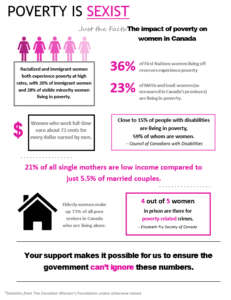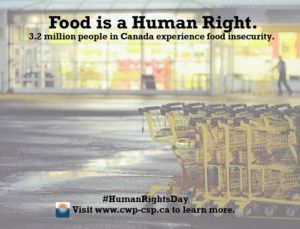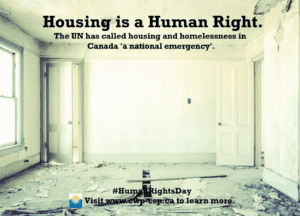An Elderly _____ Person Is Most Likely to Live With His or Her Family.
The post-obit are statistics about the electric current reality of poverty in Canada.
- 1 in 7 (or 4.9 million) people in Canada live in poverty.
- In Edmonton, i in 8 individuals is currently living in poverty.
- Poverty costs Canada billions of dollars annually.
- Precarious employment has increased past nearly 50% over the by two decades.
- Between 1980 and 2005, the average earnings amidst the to the lowest degree wealthy Canadians fell by twenty%.
- Over the by 25 years, Canada's population has increased by xxx% and yet annual national investment in housing has decreased by 46%.
Some members of society are specially susceptible to the furnishings of poverty. The following statistics propose groups who are particularly likely to experience poverty.
- People living with disabilities (both mental and concrete) are twice as likely to live beneath the poverty line.
- Well-nigh 15% of people with disabilities alive in poverty, 59% of whom are women.
- Estimates place the number of homeless individuals living with a inability or mental affliction as high every bit 45% of the overall homeless population.
- Children with disabilities are twice as likely to live in households relying on social help
- 21% of single mothers in Canada heighten their children while living in poverty (7% of unmarried fathers raise their children in poverty).
- Women parenting on their own enter shelters at twice the rate of two-parent families.
- Indigenous Peoples (including Beginning Nations, Métis, and Inuit peoples) are overrepresented amongst the homeless population in near all urban centres in Canada.
- 28%-34% of shelter users are Indigenous.
- ane in 5 racialized families lives in poverty in Canada, equally opposed to ane in xx not-racialized families.
- Racialized women living in poverty were well-nigh twice as likely to work in manufacturing jobs than other women living in poverty.
- Overall, racialized women earn 32% less at work.
- Most xv% of elderly unmarried individuals live in poverty.
- Nearly 2 million seniors receive the Guaranteed Income Supplement and live on nigh $17,000 per year. However, the most bones standard of living in Canada is calculated at $18,000 per year for a single person.

Click to enlarge
Children and youth under xviii are particularly vulnerable to weather condition of poverty. The following statistics outline take chances factors and the realities of youth poverty in Canada.
- In Canada, 1.three million children live in conditions of poverty (that's 1 in 5).
- 1 in 2 Condition Kickoff Nations children lives in poverty.
- 8% of children in British Columbia live in poverty with children under the age of 6 representing an fifty-fifty college poverty rate of xx.one% (both are higher than the national boilerplate of 18.5%)
- i in v Edmontonian children (under the historic period of 18) live in poverty, which increases to 1 in three children in single-parent families.
- 40% of Ethnic children in Canada alive in poverty, and 60% of Indigenous children on reserves alive in poverty.
- More than i-third of food bank users across Canada were children in 2016.
- Well-nigh 1 in 7 of those using shelters in Canada are children.
In Canada,
0
children live in poverty
1 aspect of poverty is not having enough food or having limited access to nutritious and good for you food. The following statistics outline the reality of hunger in Canada.
- Residents in Nunavut spend twice as much on food equally the rest of the land on average ($xiv,800 five. $seven,300 annually).
- 4 one thousand thousand people in Canada experience food insecurity.
- ane in eight Canadian households struggles to put food on the table.
- In 2014, the bulk of food-insecure households – 62.2% – were reliant on wages or salary from employment.
- 8 out of 10 provinces saw an increase in nutrient banking company usage in 2016.
- 62% of children living in the North are nutrient insecure.
- 2 out of every 5 Northern households are food insecure.
- Foodbank usage across Canada is 3% college than in 2015 and 28% higher than it was in 2008.
- In Nunavut, 7 of 10 Inuit preschoolers live in food-insecure households.
- Foodbank usage has increased in all provinces since 2008, apart from Newfoundland and Labrador.
- 2% of nutrient depository financial institution users are Indigenous.

Click to enlarge
Homelessness is the virtually obvious expression of poverty'southward effect on housing, but it's not the only one. The post-obit facts delve into housing instability and homelessness in Canada.
- 3 million Canadian households are precariously housed (living in unaffordable, below standards, and/or overcrowded housing conditions).
- An estimated 235,000 people in Canada experienced homelessness in 2016, with roughly 35,000 people being homeless on whatsoever given nighttime.
- Almost 1 in every 5 households experience serious housing affordability issues (spending over 50% of their low income on rent) which puts them at take chances of homelessness.
- Three-quarters of Yukon's population live in Whitehorse where the average price of housing increased 80% over half dozen years.
- Estimates identify the number of homeless individuals living with a inability or mental disease equally high as 45% of the overall homeless population.
- In Toronto, in that location were five,219 people who were homeless in 2013 (the latest bachelor data). Roughly half of the homeless population were on waitlists for affordable housing during the same period.
- Canada Mortgage and Housing Corporation predict that its major national housing program funding will fall from $iii.04 billion (2010) to $one.68 billion by 2017 — a $1.36 billion difference.
- According to new research, spending $10 on housing and support for loftier-need chronically homeless individuals resulted in well-nigh $22 of savings related to health care, social supports, housing, and the justice arrangement.
- Youth aged xvi-24 make up about 20% of the homeless population
- The number of older adults and seniors experiencing homeless is ascension, making upward a combined 4% of shelters users in 2016

Click to enlarge
Source: https://cwp-csp.ca/poverty/just-the-facts/